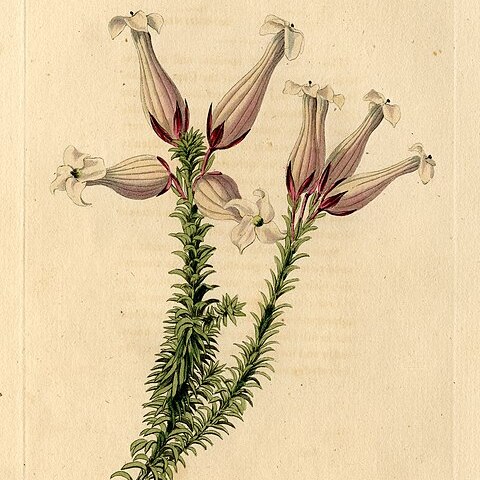Erect shrub up to 60 cm (2 ft) or so, glabrous. Leaves 4-nate, 4-8 mm long, adpressed at the base, erect-recurved to sub-squarrose, ovate to lanceolate, blunt, imbricate, sulcate, thick, ciliate, aristate at the apex, the floral more or less, sometimes much, dilated. Flowers in umbels of 3, usually 4, flowers; peduncles 6-8 mm long, stout; bracts approximate, 6-8 mm long, oblanceolate or lanceolate, ciliate, reddish. Sepals 6-8 mm long, narrow-ovate to oblong, keeled, ciliate, aristate, crimson. Corolla 1.3-2.4 cm long, ampullaceous; tube ovoid or subglobose below, more or less gradually narrowed to the neck then slightly dilated at the throat, viscidulous, pale rose with darker, red veins and darker below the lobes; lobes 4-6 mm long, spreading, broad ovate, very obtuse, more or less crenulate, white or edged with red. Filaments dilated below the anther; anthers included, 2-3 mm long, lateral, subcrescent-shaped, acute, slender, prognathous and bilobed at the base, pallid, muticous. Ovary elongate, subsessile on a short, broad stipe; style at length exserted; stigma capitate.
More
Erect, glabrous, 1-1 1/2 ft. high; branches of straggling habit, rigid; leaves 4-nate, adpressed at the base, erect-recurved to subsquarrose, oval to lanceolate, blunt, thick, ciliate, 2-4 lin. long, the floral more or less (sometimes much) dilated; umbels 3-4-flowered; pedicels stout, 3-4 lin. long; bracts approximate, oblanceolate or lanceolate, ciliate, reddish, 3-4 lin. long; sepals oblong, obtuse, ciliate, crimson3-4 lin. long; corolla ampullaceous; tube ovoid or subglobose below, more or less gradually narrowed to the neck, then slightly dilated at the throat, viscidulous, 9-12 lin. long, pale rose with darker red veins; segments spreading, broad ovate, very obtuse or subreniform, crenulate, while (or spotted or edged with red), 2-3 lin. long; filaments widened at the anther; anthers suberescent-shaped, acute, slender, prognathous and bilobed at the base, pallid, 1-1 1/4 lin. long, muticous; ovary subsessile or on a short broad stipe.
Erect shrublet to 50 cm. Flowers large, variably ampullaceous with spreading lobes, white to pink.

